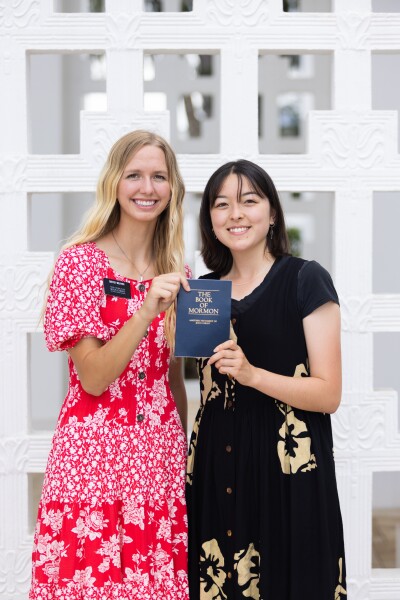
In January 2022, the new Hawaii Laie Mission was created, a separation from the Hawaii Honolulu Mission. The new mission includes the Laie Hawaii Temple Visitors' Center, three young single adult stakes near BYU–Hawaii and two stakes in the Laie area. Since the creation of the mission, only sisters have been called as young full-time missionaries, with the exception of some elders who were assigned from the Honolulu Hawaii Mission to serve in Laie for nine months. The mission also includes senior missionaries serving in the area at the Polynesian Cultural Center and BYUH.
Differences from the Hawaii Honolulu Mission
Due to the small size and close proximity of Laie, the special location provides the missionaries of the new mission with unique opportunities and experiences. Elder Malachi Ae, serving in the Laie from California, shared all of the missionaries have grown very close together and see each other very frequently, including the mission president. Ae said serving in this mission and being close to everyone in the area feels like a big family since everyone has each other’s backs.
Several missionaries who once served in the Hawaii Honolulu Mission were called to move permanently to the Laie Hawaii mission. This switch brought about some changes. Sister Minami Ford, from Ohio and serving in Laie, said when she was previously part of the Hawaii Honolulu Mission, they had the Honolulu Mission president but at the Visitors’ Center there was a director who was over all of the missionaries in the area. However, she explained that now the Laie Mission now has its own mission president over the whole area and the Laie Mission office is next to the Visitors’ Center.
Ford shared what a typical day looks like for sister missionaries in the Hawaii Laie Mission. She said as a companionship, they usually spend two hours at the Visitors’ Center and then two hours at the Teaching Center, where they teach online and help with the church’s Come Unto Christ website. Ford added the sisters spend the rest of the day in their areas out in the field. Additionally, she said once a week, they give live bus tours of Laie on trams from the PCC for visitors and guests.
Favorite parts of the mission
With the new mission, missionaries said they are able to connect more deeply with the diverse community of locals and BYUH students. Ford said, “Meeting so many different people from all over the world is my favorite part in this mission. … We're just able to learn about so many different cultures and perspectives and get to experience so many different [things] and [learning] from [people's] experiences just as much as we're teaching them.”
She said her companion, Sister Weaver, has met and been able to talk with people from Uganda and Ford has been in contact with “people in Burundi and the Philippines and all over the United States.” Sister Japrix Weaver, a missionary from Utah serving in Laie and Ford’s companion, explained as long as missionaries are genuine and caring about individuals' perspectives and respectful of their cultures, then they're happy to share their culture.
Another special highlight for the missionaries serving in Laie is the opportunity to serve so close to the temple, shared Elder Brayden Richardson, a full-time missionary in the Hawaii Laie mission from Utah. He said, “The temple is such a central part to this mission.” Ae expressed he loves how missionaries in Laie get to see the temple almost every single day. He said he can feel the spirit of being on the temple grounds often.
Witnessing the power of The Atonement
With Laie as a popular tourist location, Laie missionaries have the opportunity to teach people from a variety of spiritual backgrounds. Weaver said seeing how personal the gospel is to each person is her favorite part of her mission. She explained at the Visitors’ Center, many people who enter just believe in Jesus Christ but aren't members of the church.
She said, “They still have a good relationship with Jesus Christ, and it's amazing to see how they have that relationship or even ward members. It's fun to talk to returned missionaries and they share stories of how Jesus Christ helped them. It's seeing how the Atonement of Jesus Christ is for every single person.”
A students part
The missionaries in Laie expressed their desire for BYUH students to participate in the work of the Lord by not only sending referrals but also in more simpler ways.
Richardson suggested, “Be a good example wherever you go as a BYU–Hawaii student because the community and people who are just visiting here see you, and it shows them that BYUH students respect and care about them.” He said BYUH students do not have to say anything special, but the things the students do will make everybody feel more welcomed and invited.
Additionally, Weaver said students being involved with their wards and participating in the activities, such as Family Home Evening, Relief Society activities and going to Institute, are ways they can contribute to missionary work.
She said, “Just being there and becoming friends with your ward makes it easy [and] you can share your testimony in those activities. It's a good way to just become friends with everyone. Most activities have a spiritual thought and [students] can help participate in those.” Weaver said students inviting their ward members to attend activities with them is also a great way to perform missionary service.

